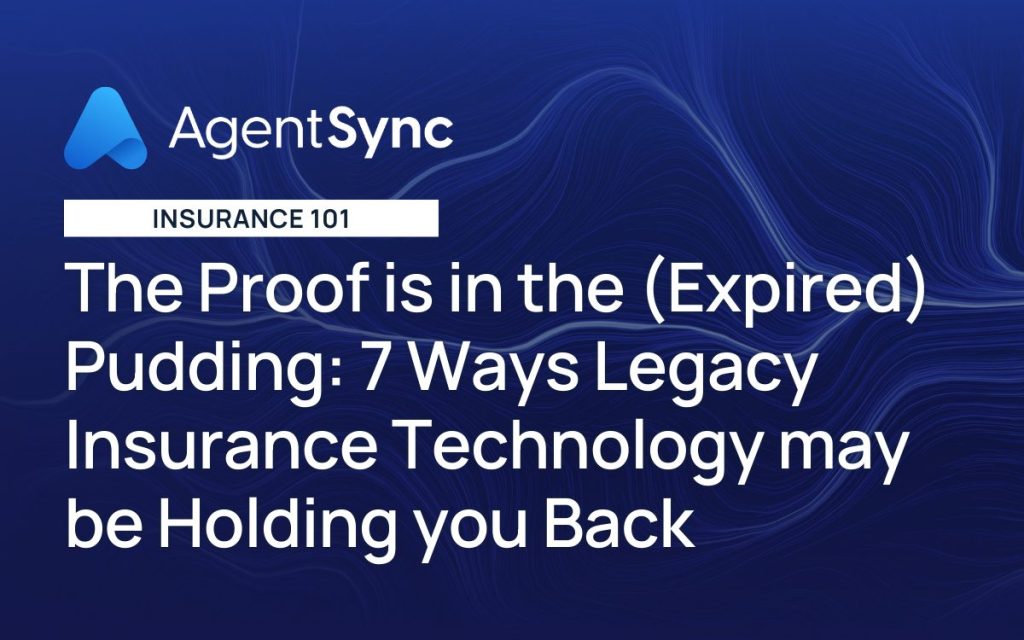The Proof is in the (Expired) Pudding: 7 Ways Legacy Insurance Technology May Be Holding you Back

The Southwest Airlines catastrophe that rounded out 2022 may have been a nightmare for everyone involved, but there was one positive that came out of it. The debacle helped start a larger conversation on a topic we’ve been talking about for quite some time now: the problem with outdated technology. As we begin the new year, we anticipate professionals across all industries taking a closer look at the cracks in their technological infrastructure and legacy systems.
Legacy technology and the insurance industry often go hand in hand
The insurance industry is no stranger to outdated technology. As a legacy industry, legacy tech is par for the course. It wasn’t until the COVID-19 pandemic began causing business shutdowns that many insurers were basically forced to update their processes and softwares in order to continue operating under new safety guidelines.
In many ways, the COVID-19 pandemic was the catalyst for the insurance industry’s digital revolution. But, countless carriers and agencies are still relying on the old way of doing things. Why is that?
The answer isn’t straightforward. Some may be worried about the cost while others are more concerned with the challenge of replacing legacy systems. Some are just afraid the change will be too much for employees and that it’ll cause more business disruption than it’s worth. However, if Southwest’s breakdown taught us anything, it’s that no excuse is worth risking the damage that outdated technology can cause to your organization, employees, and customers.
So, without further ado, here are seven ways your legacy system may be causing your insurance business more harm than good.
**We’ll be exploring these problems from an insurance perspective (as that’s our expertise), but many of these problems apply to businesses in any industry that still rely on outdated technology.
1. Legacy technology is cost-heavy
One of the more common roadblocks we hear from insurance experts who are still running their business on outdated systems is that a new solution is just not in the budget. While it’s true that the upfront costs of adding more modern tools to your tech stack may be substantial, they’re nothing compared to the cost of maintaining legacy systems. Choosing to keep doing things the way you’ve always done them because it seems easier (or cheaper) now is known as technical debt. And like most debts, they eventually come due.
The older systems get, the more they cost to maintain. Plus, legacy technology could be eating away at an organizations’ bottom line in other, less obvious ways. For example, an outdated agency management system (AMS) or customer relationship management system (CRM) might not be able to offer the features or ease of use that employees, producers, clients, and downstream distribution channel partners are looking for. If these customers, employees, and partners aren’t satisfied with their experiences, they may take their business (and their talent) elsewhere, in search of a more modern experience.
2. Legacy technology can harm your reputation
You work hard to maintain a positive reputation for your insurance business. A poor reputation could lead your clients straight into the hands of your competitors and negatively impact your bottom line. We saw first hand how outdated technology managed to drag Southwest Airlines’ reputation through the mud in a matter of days.
When it comes to insurance, there doesn’t necessarily need to be a massive breakdown or error with your legacy system to negatively impact how current and potential customers and employees view your company. It can also be the day-in-day-out tedium of outdated technology that finally gets to people. If you continue using legacy technology, employees, prospects, and clients may view your company as being behind the times. And if your technological infrastructure looks like it’s stuck in the past you’ll have a harder time convincing anyone of your future spot in the market.
3. Legacy technology could get you in regulatory trouble
A major drawback of legacy technology is its inability to integrate with newer software. Insurance professionals need systems that can communicate with each other and paint a complete picture of their data in order to make informed business decisions. The complexity of the insurance industry’s state-by-state regulation system means it’s crucial for all systems to be integrated and updated in real time to avoid compliance violations.
Updating to an automated integrated compliance solution (like AgentSync) can create significant compliance management cost savings and ensure continuous producer and agency compliance – without the manual effort that you’d need to ensure the same level of compliance today.
4. Legacy technology can inhibit growth at your agency, carrier, or MGA/MGU
Legacy systems are rarely scalable. Modern problems need modern solutions and legacy technology is often unequipped to address current needs. Because of this, legacy systems can be a major barrier to an organization’s growth and innovation.
The longer an agency waits to update its legacy systems, the harder it will be to address current market needs and gain new market share. If you’re not ready to completely overhaul your organization’s legacy systems, there are other options that can help you dip your foot in the pool of innovation.
5. Legacy technology fuels inefficient workflows
Legacy systems can block your organization from realizing its full potential. With outdated technology, it’s likely your staff is spending too much time on manual, repetitive, and non-revenue-generating tasks. Not only is this a waste of talent, but it also increases the chance of human error and non-compliance.
Without updated insurtech, processes like producer onboarding and compliance management eat up a lot more time and resources. Remember earlier when we mentioned that legacy systems don’t usually integrate easily with other technology? This lack of communication can create data and workflow silos that block information from flowing between teams and ultimately slow down processes.
6. Legacy technology could make you more vulnerable to cyber attacks
Hackers are constantly finding new ways to sneak past an organization’s cyber security measures and access its secure data. As software ages, it may not have the defenses needed to protect against newer cyber threats. Cyber security is a big concern for insurance agencies and carriers which often store vast amounts of sensitive client information. Outdated software could make that data more vulnerable to a data breach, bringing you right back to previous points about reputational harm and hard dollar costs.
7. Legacy technology could negatively impact hiring efforts
We’ve said it before and we’ll say it again – the insurance industry is in the midst of a hiring crisis. Mass retirement and a shrinking talent pool means high-quality candidates have more power to choose where they’d like to work. And if you think the chance to work with software that predates their grandmother is a good selling point then oh boy do we have news for you.
Today’s job-seekers are looking for modern companies that are using the latest technology to improve both the customer and employee experience. Offering producers a high-tech experience with less time spent on manual, repetitive, time-consuming tasks could help as you continue to compete for talent.
The time to modernize your insurtech is now!
The best by date on your insurtech has come and gone and it’s time to rethink the “if it ain’t broke, don’t fix it” mindset you may have previously held regarding your legacy systems. In reality, it’s much better to fix the problem before a major malfunction (again, you just have to look at Southwest Airlines for proof). Clearly, outdated technology can do a lot more harm than good when it comes to your agency, carrier, or MGA.
Don’t be like Southwest and wait until the damage is already done. The time has come to throw out your legacy systems along with the problems they’re causing your insurance business. If you’re ready to declare your independence from outdated tech and processes see how AgentSync can help you reach your full potential.

